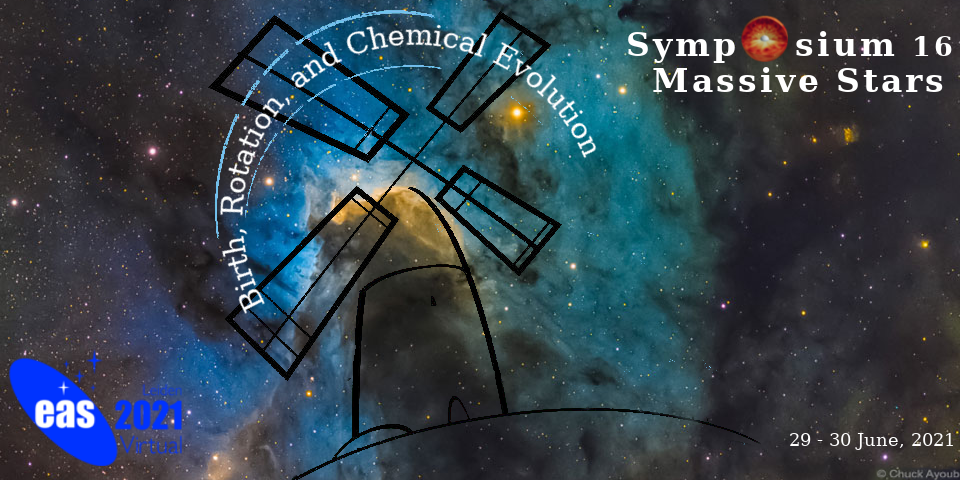Symposium S16
29-30 June 2021
Massive stars: birth, rotation, and chemical evolution

News:
All participants are welcome to join our Slack channel (#s16_massive_stars) for discussions during and after the symposium.
Aims and scope
Massive stars are important drivers of galaxy evolution via their strong ionising radiation, momentum transfer, and chemical enrichment. In fact, some elements produced by massive stars are also crucial building blocks of planets and life. However, massive star formation and evolution are subject to fundamental uncertainties. This symposium is divided into three parts, each of which will highlight a specific phase in the life of a massive star.
In the first part, the focus will lie on massive young stellar objects (mYSOs). The goal of the sessions is to discuss mYSO evolution from the earliest phases in dense clouds up to their arrival on the zero age main sequence (ZAMS). This will include topics such as cloud collapse and dense core formation; disk formation, fragmentation and dissipation; accretion phenomena and mechanisms; Herbig Be stars; as well as multiplicity.
In the second and third parts, the main sequence and post-main sequence phases will be scrutinised, with focus on rotational mixing (or more broadly, chemical mixing), which drastically modifies evolutionary pathways. This directly impacts the evolutionary fate of massive stars and their end products, which include gravitational-wave progenitors such as neutron stars and black holes. Despite its significance, the mixing processes in massive stars are poorly known and remain calibrated within order-of-magnitude estimates in evolutionary models. Moreover, stellar winds and binarity can affect the surface abundances of stars, leading to further uncertainties when inferring internal chemical mixing processes.
In this symposium, we are bringing together an international group of experts from within and outside of Europe across all career stages. The focus is on combining recent constraints from the key research areas of photometry, spectroscopy, asteroseismology, and stellar evolution modelling, and bridge observations, theory and modelling efforts in this important area of stellar astrophysics. Ultimately, our goal is to improve evolutionary models and our understanding of massive star evolution from birth to death.
Programme
The 6 symposium blocks are distributed into a 2:3:1 format covering mYSOs, main sequence, and post-main sequence evolution. Additionally, 2 lunch blocks are dedicated to poster presentations / flash talks.
- Session S16a: Massive YSOs: embedded phase
(Dense cores, proto-stellar disks and objects as observed at radio/mm wavelengths)
- Session S16b: Massive YSOs: end stages
(Optically revealed PMS/ZAMS objects and their (transition) disks, multiplicity, Herbig Be stars)
- Session S16d: Main Sequence: Asteroseismology
(Internal gravity waves, mixing profiles, internal rotation profiles)
- Session S16e: Main Sequence: Spectroscopy
(Surface chemical enrichment and observational constraints)
- Session S16f: Main Sequence: Stellar evolution modelling
(Mixing processes and composition gradients in models of stellar structure and evolution)
- Session S16h: Post-main sequence
(Surface abundances, mixing processes, the impact of mass loss)
- Session S16c (starts at 12:50) - Tuesday lunch session: Flash talks - Main sequence and post-main sequence.
Presenters:
David R. Aguilera-Dena, Andrew Allan, Hannah Brinkman, Levin Hennicker, Devesh Nandal, Sebastien Martinet, Sarah McDonald, Nicolas Moens, Daniel Pauli, Monica Rainer, Yves Sibony, Nagaraj Vernekar, Przemyslaw Walczak
- Session S16g (starts at 12:50) - Wednesday lunch session: Flash talks - Massive YSOs.
Presenters:
Olga Bayandina, Annelotte Derkink, Alexis Quintana Isasi, Cyprien Lanthermann, Dominique M.-A. Meyer, Rebecca Pitts, Abel Schootemeijer, Ana Rita Costa Silva, Bringfried Steckl, Bethan Williams, Alejandra Zaavik Lugo Aranda
Invited speakers
- Sarah Ragan (Cardiff University, UK)
- Alessio Caratti o Garatti (Dublin Institute for Advanced Studies, Ireland)
- May Gade Pedersen (Kavli Institute for Theoretical Physics, USA)
- Fabrice Martins (Université de Montpellier, France)
- Raphael Hirschi (Keele University, UK)
- Emma Beasor (NSF's NOIRLab, USA)
Scientific organisers
- Zsolt Keszthelyi (Chair, Universiteit van Amsterdam, the Netherlands)
- Dominic Bowman (Co-chair, KU Leuven, Belgium)
- Miriam García (Co-chair, Centro de Astrobiología, Spain)
- Hanneke Poorta (Co-chair, Universiteit van Amsterdam, the Netherlands)
- Paul Crowther (University of Sheffield, UK)
- Jadwiga Daszyńska-Daszkiewicz (Uniwersytet Wrocławski, Poland)
- Sylvia Ekström (Université de Genèva, Switzerland)
- Pamela Klaassen (UK Astronomy Technology Centre, UK)
- Rolf Kuiper (Universität Tübingen, Germany)
- René Oudmaijer (University of Leeds, UK)
- María C. Ramírez-Tannus (MPIA Heidelberg, Germany)
- Willem-Jan de Wit (ESO, Chile)
Contact
z.keszthelyi @ uva.nl
Updated on Mon Jun 28 14:40:08 CEST 2021
|